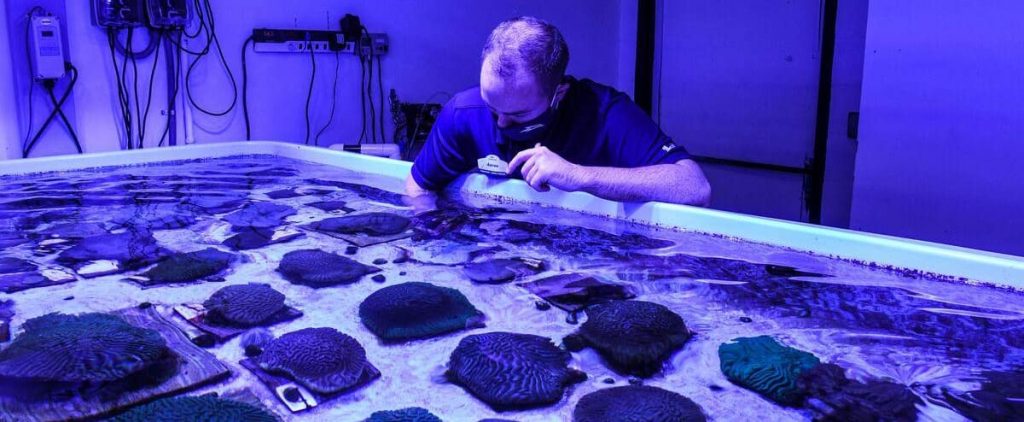ORLANDO, United States | Pipette in hand, Aaron Gavin carefully feeds corals with shrimp porridge. In Orlando, Florida, there is a state-of-the-art laboratory of more than 700 coral colonies in an effort to save precious animals from a mysterious disease.
Here corals live in large aquariums under lamps that mimic sunlight. For a biologist, it’s a fascinating sight. Like his colleagues, he has never had contact with these Florida reefs, vital to marine biodiversity, and every day with them is a lesson.
Since 2014, hard coral tissue loss disease has spread at full speed across the Florida Reef, which stretches about 580 kilometers from the dry Tortugas Islands to St. Lucia Cove about 200 kilometers north of Miami.
It has killed nearly half of the stony corals on the reef. Its origin is unknown and cannot be cured at the present time and it is widespread in the Caribbean.
In front of the Florida Keys, near the sandy beaches, the disaster hides. Great white patches underwater: dead corals.
“It’s heartbreaking and I think the most disturbing thing is that most people don’t know it’s happening,” Michelle Ashton, director of communications for the Florida Wildlife Foundation, laments.
original project
In 2018, with more than 20 of the area’s 45 hard corals species threatened with extinction, the US Oceanic and Atmospheric Monitoring Agency (NOAA) and the Florida Wildlife Commission created an animal rescue group.
A plan is made. The goal: to extract corals from areas not yet affected by the disease and take care of them, so that they can later be returned to the sea.
This unprecedented project quickly brought together dozens of public and private institutions. The Florida Coral Rescue Center in Orlando is an essential part of the operation.
“We are keeping corals safe and sound. If they were still in the wild, up to 90% of them would have died,” explains Justin Zimmerman, who oversees this lab set up in 2020 and operated by water park company SeaWorld.
Everything is done to get as close as possible to the natural environment of these animals. Aquariums are full of salt water, contain rocks and fish from the ocean, and can simulate ocean currents.
“What you’re seeing is the future of Florida’s reefs,” says Michelle Ashton. It is the descendants of these corals who will return to the ‘ocean’.
important consequences
The first part of the plan saved nearly 2,000 coral colonies spread across 20 institutions in 14 states in the country.
The second is to prepare for a successful return to the ocean, but it will likely take a long time because the corals are growing slowly.
Scientists are studying the genes of the rescued animals, with a plan to create new samples that are more resistant to disease, ocean warming or pollution.
The results of this research will have important consequences for the region.
Hard coral reefs, with their limestone hull, form the structure that supports the reef, which hosts 25% of marine life and provides a natural barrier that protects coastlines by reducing wave strength, especially during hurricanes.
The economic aspect is also important: In Florida, tourism from fishing and diving brings in $8.5 billion annually according to a study.
Hence the concern of Steve Campbell, 59, a resident of Key Largo.
“I’ve lived in the Florida Keys for 20 years,” he says, sitting beside his small boat. “I go to the water every day and that’s how we live here, and we take people to see the reef. So it’s very important to us.”
See also…

“Total coffee aficionado. Travel buff. Music ninja. Bacon nerd. Beeraholic.”









More Stories
Fluoroscopy | “Self-coup”?
This is why you find it difficult to wake up in the morning.
She meets her boss at the airport after taking sick leave.